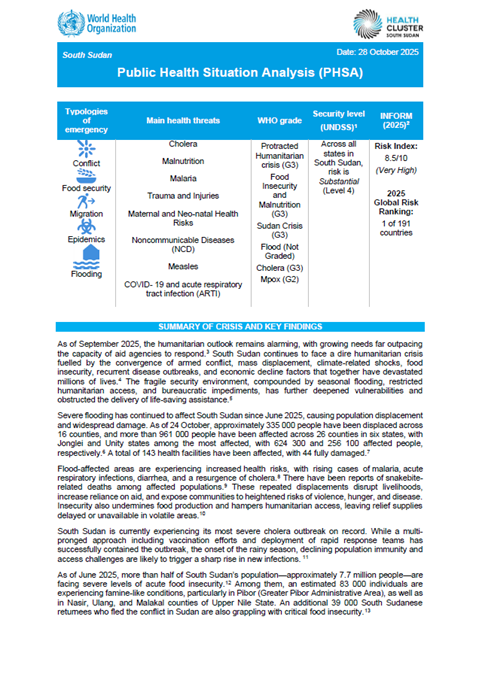Public Health Situation Analysis - South Sudan
29 October 2025

Overview
As of September 2025, the humanitarian outlook remains alarming, with growing needs far outpacing the capacity of aid agencies to respond. South Sudan continues to face a dire humanitarian crisis fueled by the convergence of armed conflict, mass displacement, climate-related shocks, food insecurity, recurrent disease outbreaks, and economic decline factors that together have devastated millions of lives. The fragile security environment, compounded by seasonal flooding, restricted humanitarian access, and bureaucratic impediments, has further deepened vulnerabilities and obstructed the delivery of life-saving assistance.
Severe flooding has continued to affect South Sudan since June 2025, causing population displacement and widespread damage. As of 24 October, approximately 335 000 people have been displaced across 16 counties, and more than 961 000 people have been affected across 26 counties in six states, with Jonglei and Unity states among the most affected, with 624 300 and 256 100 affected people, respectively. A total of 143 health facilities have been affected, with 44 fully damaged.
Flood-affected areas are experiencing increased health risks, with rising cases of malaria, acute respiratory infections, diarrhea, and a resurgence of cholera. There have been reports of snakebite related deaths among affected populations. These repeated displacements disrupt livelihoods, increase reliance on aid, and expose communities to heightened risks of violence, hunger, and disease. Insecurity also undermines food production and hampers humanitarian access, leaving relief supplies delayed or unavailable in volatile areas.
South Sudan is currently experiencing its most severe cholera outbreak on record. While a multi-pronged approach including vaccination efforts and deployment of rapid response teams has successfully contained the outbreak, the onset of the rainy season, declining population immunity and access challenges are likely to trigger a sharp rise in new infections.
As of June 2025, more than half of South Sudan’s population - approximately 7.7 million people - are facing severe levels of acute food insecurity. Among them, an estimated 83 000 individuals are experiencing famine-like conditions, particularly in Pibor (Greater Pibor Administrative Area), as well as in Nasir, Ulang, and Malakal counties of Upper Nile State. An additional 39 000 South Sudanese returnees who fled the conflict in Sudan are also grappling with critical food insecurity.
